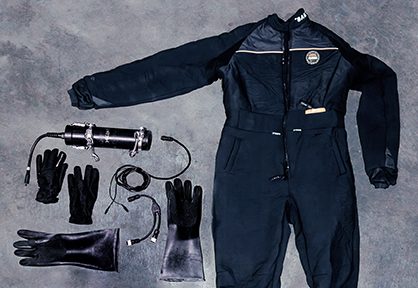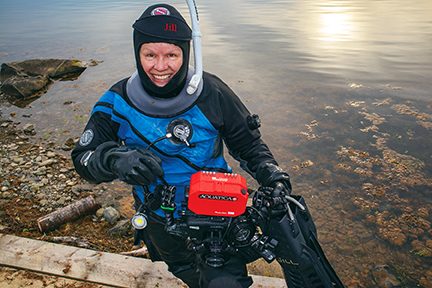GETTING COLD ON A DIVE IS UNPLEASANT, but if it progresses to hypothermia, it becomes potentially fatal. Even more than discomfort, considering the physiological and psychological stress it can cause, being cold is potentially risky.
Every diver has an individual tolerance to temperature exposure, especially to cold water. A diver’s resilience regarding temperature will vary from day to day. Upgrading your thermal protection is one way to combat the cold. You might go from a 3 mm to a 5 mm wetsuit, from a wetsuit to a drysuit, or from a thin layer of ski underwear to heavy fleece undergarments under your drysuit.
Using heated undergarments or heated vests to keep either your core or your entire body warm is a further step. Many divers who have started using these devices are not planning to return to standard warming gear.
Previously expensive and hard to find, heated vests and undergarments are readily available in many dive shops today and are becoming more popular in recreational diving. How do these devices hold up when it comes to safety? What should a diver consider? Is heated underwear the right choice for you? This article should clear up some confusion about heated garments and how to properly use them.
What Is Available?
Some drysuit manufacturers have been selling electrically heated undergarments for years. These undergarments work with their drysuits to insulate the body and sometimes the hands and feet. You can now find heated vests and full undersuits from independent companies, ranging from integrated heating coils to pouches that you can stuff with molded heating pads. Power comes from rechargeable internal or external batteries carried in pockets in the vests or undergarments. The connectors, batteries, and heating elements are tested and approved for different environments and rated to specific water-resistance standards.
It is important to note that not all heated undergarments and vests are for underwater use or immersion. If you can use them for diving, they might be safe for wetsuits or only suitable for drysuits. It is important to follow the manufacturer’s recommendations. Products specifically designed for other activities, such as motorcycle riding or hunting, are not generally for use in water unless they have the appropriate rating.
Thermal Impact
on Decompression
A study conducted at the Navy Experimental Diving Unit (NEDU) and published in 2007 involved exposing divers to four different dive profiles in a hyperbaric chamber’s wet pool. They did not wear thermal protection and were either exposed to warm (97°F/36°C) or cold (80°F/27°C) water in the dive’s different phases. The divers were either warm or cold for their bottom time and decompression, warm during bottom time and cold during decompression, or vice versa.
The researchers tested selected dive profiles, and the experiments showed that in the cold bottom and warm decompression trials, some profiles showed no incidents of decompression sickness (DCS). The same profile with the inverse temperature profile resulted in a significant number of DCS incidents. While this is an oversimplified description of this well-designed and intensive study, it provides valuable insights into the potential thermal impact on decompression physiology.
What does this mean for trying to combat the cold with heated undergarments? In short, you need to be mindful of the heating device’s effects on your on- and offgassing and your risk of decompression stress. When your body is warm, your blood vessels will dilate. Dilated (widened) blood vessels allow more gas to move in and out of the surrounding tissues, which means the on- and offgassing of those tissues can occur faster than in the cold.
Constricted blood vessels on- and offgas more slowly, but that doesn’t mean that being cold on a dive is preferable. On the contrary, an uncomfortable diver will likely become stressed, which can take away from the joy of diving and become a safety risk.
Consider the following scenario: You have your new heated vest turned on during the descent and bottom portion of the dive. You chose a low setting despite freezing temperatures because you read this article and know that you will experience increased ongassing during bottom time than you would with no additional heat. The plan was to switch to a higher temperature for ascent and increase your comfort during the decompression phase. If the vest failed right before ascent, however, your body might not be able to offgas as well, potentially increasing your risk of developing DCS.
Safety Considerations
and Failure Points
Divers rely heavily on technology. While we all know that we need a backup plan for a potential computer failure, many divers do not consider a fallback option for that critical piece of equipment. Electronic devices are prone to failure, and your heated vest or undergarments may stop working. You shouldn’t plan your dive relying on the fact that your heating device will keep you warm. It might not be fully charged, the electronics might malfunction, or you might have forgotten to take the remote control with you and notice only when you are already well underway.
When choosing your heated vest or undergarments, make sure you are wearing the correct size and know where the heating elements are. Before using it, be sure to inspect all exposed wiring, connections, and batteries for any signs of damage, and make sure you have secured and sealed the batteries and know how to switch off the device if it overheats. Avoid squeezing or folding the heating elements to prevent malfunctions or overheating. If you notice the battery pack becoming unusually hot, switch off your warming device and call the dive. Divers have reported squeezes from inaccurately folded heating layers and burns from directly exposing their skin to the heating element without a clothing layer between their heating vest to shield their skin.



© Alert Diver — Q2 2022